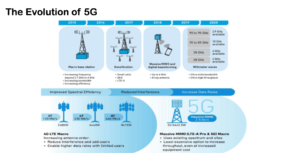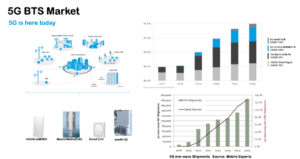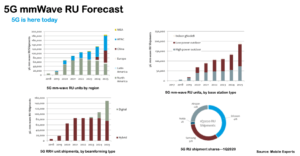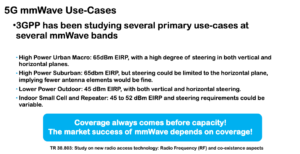What are the changes we can see from 4G to 5G?
The increase in network frequency
Since 6 years ago, the network has gradually transitioned from 4G network to 5G network, and one of the most obvious changes is the increase of network frequency. In the 4G era, we mainly used frequencies of 2.6GHz and below, but in the 5G era, the frequency band has been expanded to Sub 6GHz, and the arrival of millimeter waves has increased the network frequency to higher frequency bands such as 28GHz and 39GHz.

Entering the 5G era, another obvious change is the increase in bandwidth.
In the 4G era, the bandwidth of the network was 2×20MHz. In the 5G era, the bandwidth has been greatly improved. For example, the bandwidth of the 3.5GHz network is already as high as 200MHz, and some OEM manufacturers have brought bandwidths such as 300MHz and 500MHz. The introduction of a millimeter-wave can extend the network bandwidth to 2GHz.
In this case, the improvement of the full-page efficiency of the base station is also an important concern for everyone.
“To achieve the designer’s goal, this involves the performance improvement of key components such as PA. In the 4G era, everyone basically used LDMOS PAs in the base station, and in the 5G era, everyone turned their attention to higher applicable frequency bands.
GaN PA with better efficiency,” said Jenny Xun, engineer manager of Qorvo’s Wireless Infrastructure Business Unit (hereafter referred to as Jenny). She further pointed out that in terms of product form, 5G base stations have undergone unprecedented changes compared with similar products in previous networks.
In the 4G era, the layout of base stations is dominated by the configuration of macro base stations and micro base stations. But in the 5G era, the base station forms are more diverse. Sub 6G mMIMO, indoor small base stations and mmWave base stations will play an important role, which also brings opportunities to manufacturers.

Antenna Array
“The change in the antenna array is another obvious change in 5G. In the 4G era, the base station used a maximum of 8 × 8 arrays, but in 5G, the arrays have expanded to 32 × 32, or even 64 × 64, and some antennas for millimeter wave application scenarios The array is higher,” Jenny said.
Behind these technological shifts, there has been an accompanying increase in related market demand.
As shown in the figure above, 5G brings a variety of needs, among which the shipments of mmWave RUs will see significant growth. The chart below gives us a detailed performance of this market.
From a geographical point of view, before 2025, the North American market will be dominated, which has a very important relationship with the commercial use of 5G millimeter waves in the United States. After 2025, we can see that with the increased investment in China, Japan and South Korea, the Asia-Pacific region will usher in an explosion of 5G mmWave RUs. The figure below also shows the development trend of 5G mmWave RUs from two different perspectives: power and architecture.

Jenny pointed out at the meeting that according to the requirements of transmit power and scanning angle, we can divide the application of 5G millimeter wave into the following categories: one is the high-power urban macro base station. In this scenario, the requirements for EIRP are very high. 65dBm. It also has strict requirements on vertical and horizontal scanning angles; another use case is a high-power macro base station facing rural areas, which also has a high-power EIRP (65dBm), but in this use case, the vertical The scanning requirements are not so high; the third is the low-power outdoor macro base station, whose EIRP requirement is only 45dBm; in addition, there is another indoor small base station and Repeater, the EIRP requirement for this use case ranges from 45dBm to 52dBm.

“We can make predictions that network coverage will always be ahead of capacity requirements. For this reason, we need to solve the signal coverage requirements of 5G mmWave before it is possible to usher in an increase in market capacity.” Jenny said.
Jenny further stated that from the figure below, we can see the hybrid networking form of Sub-6GHz and millimeter wave. The Sub-6GHz network is used to ensure network coverage and basic connectivity, allowing people to get 5G signals wherever they go. The millimeter-wave frequency band with frequencies greater than 6GHz is used to meet high-throughput application scenarios such as stadiums, large shopping malls, and airports.
